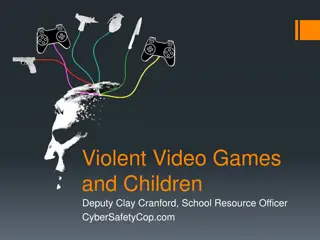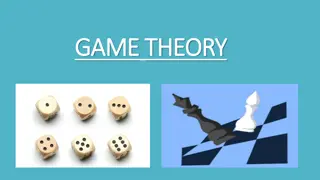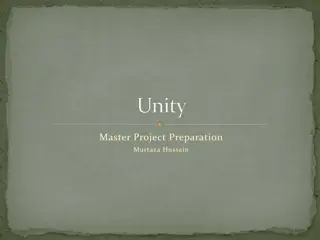Understanding Video Games as Learning Tools and Art Forms
Video games serve as both learning tools and forms of art, with CyberGames being a prominent example. They incorporate interactive elements and various genres like action-adventure games. The evolution of video game consoles and the distinction between video games and Cyber games are explored, alongside examples such as Pong, Pacman, Mario Brothers, Fortnite, and World of Warcraft.
Download Presentation

Please find below an Image/Link to download the presentation.
The content on the website is provided AS IS for your information and personal use only. It may not be sold, licensed, or shared on other websites without obtaining consent from the author. Download presentation by click this link. If you encounter any issues during the download, it is possible that the publisher has removed the file from their server.
E N D
Presentation Transcript
Video games as a learning tool and as an art form CyberGames
Schedule for Video and Cyber game project Introduction of topics: two days Examples of Games: two days Activity 1: One Day Timeline: two days Activity 2: One Day Activity 3a: Three days Activity 3b: One or Two weeks
What is a Video game and a Cyber Game? Video game: An electronic game that involves interaction with a user interface to generate visual feedback on a two- or three-dimensional video display device such as a touchscreen, virtual reality headset or monitor/TV set. Cyber game: A game played on the Internet or in cyberspace Cyber games are a type of video game. Video games cover a wider range of games. Where Cyber games are mostly interactive between multiple players using the internet, video games can be both connected to the internet or selfcontained within a console or someother means.
Examples of Video games and Cyber games Video games o Pong o Asteriods o Space Invaders o Pacman o Zaxon o Mario Brothers o Myst Video games o Doom o Quake Cyber games o Fortnite o Worlds of Warcraft o Minecraft o Roblox o Call of Duty o Online Casinos o GT5 o Prodogy o Battlefront Video game consoles Atari 2600 Saga Genesis Nintendo Playstaion Xbox
Video examples of games Pong: https://www.youtube.com/watch?v=fiShX2pTz9A Pacman: https://www.youtube.com/watch?v=i_OjztdQ8iw Mario Brothers: https://www.youtube.com/watch?v=Aw4JccvxU-s Myst: https://www.youtube.com/watch?v=e-8CFun3nEw Fortnite: https://www.youtube.com/watch?v=ezz2U6Y5ZtE Worlds or Warcraft: https://www.youtube.com/watch?v=yPS9pXKtENk Roblox: https://www.youtube.com/channel/UCjiPEaapiHbJMoAdi_L8f NA
Types of Video and Cyber games: Action games: Action games are just that games where the player is in control of and at the center of the action, which is mainly comprised of physical challenges players must overcome. Most early video games like Donkey Kong and Galaga fall into the action category. Because action games are usually easy to get into and start playing, they still, by most accounts, make up the most popular video games. Action-adventure games: Action-adventure games most frequently incorporate two game mechanics game-long quests or obstacles that must be conquered using a tool or item collected, as well as an action element where the item(s) are used.For example, in The Legend of Zelda, Link must find his way through eight dungeons to gather the scattered pieces of the Triforce of Wisdom. Once he s collected all eight pieces and assembled the artifact, Link can enter the ninth and final dungeon to rescue Princess Zelda. Link uses a boomerang to collect distant items and attack enemies.Action-adventure games like The Legend of Zelda focus more on exploration, solving puzzles, and discovering loot, while basic combat is more of a supporting activity to the overall experience. Adventure games: Adventure games are categorized by the style of gameplay, not the story or content. And while technology has given developers new options to explore storytelling in the genre, at a basic level, adventure games haven t evolved much from their text-based origins.In adventure games, players usually interact with their environment and other characters to solve puzzles with clues to progress the story or gameplay. Aside from an occasional mini-game, adventure games rarely involve any traditional video game action elements. Thus, the genre isn t very popular with mainstream gamers. Role-playing games: Probably the second-most popular game genre, role-playing games, or RPGs, mostly feature medieval or fantasy settings. This is due mainly to the origin of the genre, which can be traced back to Dungeons & Dragons and other pen and paper role-playing games. Still, hardcore RPGers don t discount sci-fi fantasy-themed RPGs like Mass Effect, Fallout, and Final Fantasy, which have helped put unique spins on the genre.Cultural differences have also had a bearing on this genre, as many gamers categorize RPGs as either WRPGs (Western-influenced) or JPRGs (Japanese-influenced). Finally, gamers are often given choices in this genre that influence the final outcome of the game, which means many RPGs have alternate endings. Simulation games: Games in the simulation genre have one thing in common they're all designed to emulate real or fictional reality, to simulate a real situation or event. Strategy games: With gameplay is based on traditional strategy board games, strategy games give players a godlike access to the world and its resources. These games require players to use carefully developed strategy and tactics to overcome challenges. More recently, these type of games have moved from turn-based systems to real-time gameplay in response to player feedback. Sports games: Sports games simulate sports like golf, football, basketball, baseball, and soccer. They can also include Olympic sports like skiing, and even pub sports like darts and pool. Opposing players in these games are often computer-controlled but can also take the form of live opponents. (And since we are on the topic of sports, video games should be considered sports themselves!) Puzzle games: Puzzle or logic games usually take place on a single screen or playfield and require the player to solve a problem to advance the action. Idle games: As technology continues to push the confines of what s possible in video gaming and as players and developers push the confines of game genres new genres are created all the time. Educational:While many parents and teachers complain about video games, there are some great educational games out there that can help with the learning process. Train in a variety of subjects, using games to make learning fun instead of boring. There are testing functions, where you can answer multiple choice questions. The most common types of education games are for math, science, and ICT. For information on the subgenres follow the attached link: https://www.idtech.com/blog/different-types-of-video-game-genres "The Many Different Types of Video Games & Their Subgenres"
Research the history of video and cyber games. Using the research that was done be able to complete a timeline of the history. In addition to the timeline, be able to discuss the topics of "How can video and Cyber games be used to as educational tools?" And "Can Video and cyber games be considered an Art form?" Activity 1: Research
Time Line: Complete the timeline with significant dates from you research. Explain why the dates you have added are significant. 1972 1972 2020
Activity 2: Class discussion on the topics of "How can video and Cyber games be used to as educational tools?" And "Can Video and cyber games be considered an Art form?" Bring in a digital slide show that shows your stance on if Video and Cyber games can be classified as an Art Form. Provide examples of how these types of games are educational tools.
Activity 3a: Create a game Using one of the applications listed below to create a basic game. Twine (Links to an external site.) (https://twinery.org/ (Links to an external site.)) is an opensource tool for telling interactive, nonlinear stories. Example: Coming Out Simulator, by Nicky Case, 2014. (Links to an external site.) Tynker (Links to an external site.), GameEditor (Links to an external site.), GameDevelop (Links to an external site.), GameSalad (Links to an external site.), MyDoodleGame (Links to an external site.), SQUEAK (Links to an external site.), GameMaker (Links to an external site.), and Scratch (Links to an external site.). Others that could be used include: Alice (Links to an external site.), Ethos (Links to an external site.), Flash (Links to an external site.), StageCast (Links to an external site.), StarLogo (Links to an external site.), and MicroWorlds (Links to an external site.). During class, each of you will have a time set up to provide a run through of your game. Be able to explain your experiences with the use of the tools.
Activity 3b: Create a game Create the basic elements of a more advanced game that has a narrative story line. Example of a theme forn the Narrative : Catch an Art thief. Narrative should have a start, middle, and ending Narrative should contain character names, a list of artworks that will be seen, and places used. Some good examples: Myst, Riven, Star Wars: Knights of The Old Republic, God of War, and Assasin's Creed The Narrative story should have an educational aspect to it. Educational aspect should have to do with art or Art History. One example: Using the ability to identify the name and the artist of a piece to move to the next level. Items that will be needed for this activity: Narrative story line Environments(Both description and Images) Character Designs
https://www.idtech.com/blog/different -types-of-video-game-genres "The Many Different Types of Video Games & Their Subgenres" oAll game images pulled from google searches: oPong oMinecraft oPacman oMyst oGod of War References:

















































